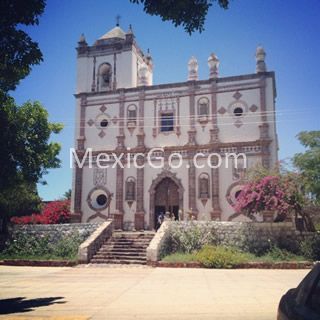In the midst of this landscape, SAN IGNACIO’s appeal is immediate even from a distance. Gone are the dust and concrete that define the peninsula, replaced by green palms and a cool breeze; it’s an oasis any desert traveler would hope for, and another excellent base for whale watching and cave-painting tours.
The settlement was founded by the Jesuits in 1728, but the area had long been populated by the indigenous Cochimí, attracted by the tiny stream, the only fresh water for hundreds of miles. Underneath the surfaced road between the highway and town is the small dam that the settlers built to form the lagoon that still sustains the town’s agricultural economy, mostly based on the Mediterranean staples of dates, figs, grapes, olives, limes and oranges. Early missionaries were responsible, too, for the attractive palm trees that give the town its character.
In town, the central Plaza Ecoturismo, shaded by six huge Indian laurel trees, plays hosts to concerts, festivals and children’s soccer games, and is dominated by Misión San Ignacio de Kadakaamán (usually open during services only) a gorgeous church constructed of lava-block walls – carved out of the output from Volcan las Tres Virgenes to the east – over one metre thick. Completed in 1786, it’s probably the best example of colonial architecture in the whole of Baja California. The left wing of the mission now houses the exquisite Museo de Pinturas Rupestres de San Ignacio (May–Oct Mon–Sat 8am–5pm; Nov–April daily 8am–5pm; free), which contains photos and cave art exhibits, with a focus on the nearby Sierra de San Francisco (Spanish-only captions).
MexicGo village in Baja California Sur, Mexico by Location: San Ignacio
| Todos Santos | Loreto | San Ignacio | Santa Rosalia |
San Ignacio, Mexico

Information
Must Know
Although whales are most in evidence in January and February, whale-watching tours to the nearby Laguna San Ignacio (2hr drive) are offered from December to April – prices are usually slightly cheaper December to January and April.
Cave-art tours from San Ignacio focus on the area of Sierra de San Francisco about 45km north of San Ignacio, where nearly five hundred sites exist across 11,000 square kilometres; tour operators usually pass through the little town of San Francisco de la Sierra and head for the easily accessible Cueva del Ratón, or remoter caves such as the Cueva Pintada and Cueva de las Flechas in Canón San Pablo, which require a minimum of two days. Note that flash photography is not allowed in the caves.
There are no banks in town, few places accept credit cards and people are reluctant to take travellers’ cheques – it’s best to come with a supply of cash. There is internet access, though, on the north side of the plaza at the Whale Watching Tours office. The Tienda Mesa general store, on the main road just off the plaza, sells hats, drinks, maps, machetes, camping gear and anything else you’d need before heading down to the lagoon or into the Sierra de San Francisco.
Cave-art tours from San Ignacio focus on the area of Sierra de San Francisco about 45km north of San Ignacio, where nearly five hundred sites exist across 11,000 square kilometres; tour operators usually pass through the little town of San Francisco de la Sierra and head for the easily accessible Cueva del Ratón, or remoter caves such as the Cueva Pintada and Cueva de las Flechas in Canón San Pablo, which require a minimum of two days. Note that flash photography is not allowed in the caves.
There are no banks in town, few places accept credit cards and people are reluctant to take travellers’ cheques – it’s best to come with a supply of cash. There is internet access, though, on the north side of the plaza at the Whale Watching Tours office. The Tienda Mesa general store, on the main road just off the plaza, sells hats, drinks, maps, machetes, camping gear and anything else you’d need before heading down to the lagoon or into the Sierra de San Francisco.
Get There
Leaving Guerrero Negro, the highway heads 142km inland. The centre of San Ignacio lies almost 3km off the main highway, where all the buses stop. Upon arrival you may be lucky enough to pick up a taxi otherwise it’s a thirty-minute walk down the road through the palms. The bus stop is actually in San Lino, a little settlement anchored by the campground and restaurant Ricardo’s Rice & Beans, just west of the intersection along a road parallel to the highway.
MexicGo © 2023
